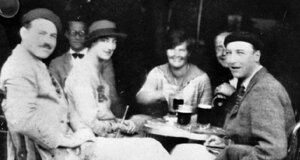What the Hell is the Lost Generation?
It was an age of miracles, an age of art, an age of excess, and an age of satire.
This is what F. Scott Fitzgerald wrote about the Lost Generation in ‘Echoes of the Jazz Age’, an article published in Scribner’s Magazine in November 1931.
Like the Baby Boomers and Generation X, Y and Z, the Lost Generation refers to the disillusioned youths born between 1883 to 1900 who spent much of their early adult lives participating in the First World War. Although the term was originally meant for the survivors of the war who were unable to settle in the routine, peaceful and mundane lives, the expression soon began to be used to describe a new horde of American writers, novelists and poets settling abroad.
After witnessing the horrors of the war first hand, the age-old ideal that good things happened to those who were virtuous was shattered and an emotionally crippled generation of young men and women returned to find a starkly different world. Although the US was involved in the World War for a short period of time, it had an adverse effect on the daily lives that a lot of people led. Technological innovation in the twentieth century ushered a life which was cleaner, safer and more affordable to most people. These young veterans soon delved into the jazz and all that the music offered. The Jazz Age saw the rise of cultural cosmopolitans with their hard drinking, fast living, urbane lifestyle on the threshold of a never-before experienced modernity and freedom of expression. Jazz music, dances like the Charleston and Lindy Hop, fashion, architecture and cinematic styles like the Flapper, Art Deco and Surrealism developed and thrived in contrast to the austere environment prior to WWI. This was the start of what is known as the Roaring Twenties.
While others rode on the new-found wave of economic success, those who ‘came of age’ during WWI, some of whom served in the military, began a vocalized rebellion against existing social, sexual and aesthetic traditions and norms. Many of them created communities in Greenwich Village and San Francisco while others sailed to Europe. Paris was the undisputable capital of these emerging literati. Although, others went to border towns such as Madrid, Munich, Casablanca and Pamplona, a majority of these artists settled on the boulevard of Montparnasse in the Latin Quarter of Paris, a locality still known for its bistros, student life and vivacious ambience.
The Parisian culture has always attracted a bohemian lifestyle – its flamboyant personalities coupled with various intellectual debates and jazz in bars and cafes around the city. Apart from all of this, Paris in the 20s was a very cheap place to live and the Prohibition Era in the US accelerated this migration. In the midst of the Avant-Garde background, the Surrealists, Dadaists, Futurists, and Expressionists all mingled together and when the literary modernists came about, they fit right in. Ezra Pound, Ernest Hemingway, F. Scott Fitzgerald, William Faulkner, Thomas Wolfe, John Steinbeck and E. E. Cummings were some of the literary giants who produced their best work in small expatriate presses in Paris. It was around this time that the term ‘the Lost Generation’ was born. Gertrude Stein, a mother goose figure for many of the writers, is widely credited with the invention of this expression.
The story goes that when a young mechanic was unable to repair Stein’s car properly, the garage owner shouted at the boy, “You are all a ‘génération perdue’ (lost generation).” When narrating the story to Hemingway, she added, “That is what you are. That’s what you all are … all of you young people who served in the war. You are a lost generation.”
Hemingway later went on to use this quote as an epigraph in his novel, The Sun Also Rises, a story about a group of expatriates who travel from Paris to Pamplona to watch the running of the bulls. Many of the novels written by Hemingway and Fitzgerald were reflective of the kind of lifestyle they led themselves. Fitzgerald’s The Great Gatsby is about high society, economic prosperity and the prohibition in New York where the illusion of happiness hides the loneliness for the main characters. Themes of self-exile, indulgence, care-free living and spiritual alienation were commonplace in these stories as these writers saw themselves exiled from mainstream American life and heritage.
To aptly put it, it was the best of times; it was the worst of times. It was the age of wisdom; it was the age of foolishness. Many of these expatriate writers succumbed to alcoholism and probably, the Prohibition back home was the reason.
Poet and author Robert McAlmon had collaborated with the stalwarts of the time such as Stein and Hemingway. His own writing however, suffered when he took to drinking. An ardent admirer as well as rival of T.S Eliot, Hart Crane was frequently involved in alcohol-induced brawls and he finally committed suicide by jumping off a ship bound to New York. The fast life and the incessant partying had finally taken a toll on the Fitzgeralds – Scott and his wife, Zelda who were once big shots on the Parisian party circuit. While Scott suffered from alcohol-related diseases for the remainder of his life, Zelda was later institutionalized for her infamous manic behavior. Other expatriates moved away from Paris to other locales by the end of the decade.
The Lost Generation thus started fading away and it might even be seen as a seemingly insignificant era. Nevertheless, writing that emerged in this time period was later an influence to other generations of artists and novelists for years to come.




















